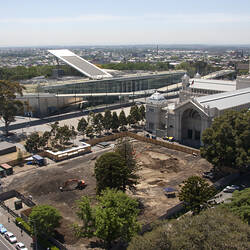Summary
By the 1830s, pressed tablewares were being mass-produced and from the 1870s pressing had become the most common manufacturing technique for cheaper tablewares.
Physical Description
Two fragments (not conjoining) from the base of a clear glass tumbler. The pressed design includes arches separated by four parallel vertical ridges. Manufacture date range is circa 1820 to circa mid-20th century.
Physical Description
Two fragments (not conjoining) from the base of a clear glass tumbler. The pressed design includes arches separated by four parallel vertical ridges. Manufacture date range is circa 1820 to circa mid-20th century.
More Information
-
Collection Names
-
Collecting Areas
Public Life & Institutions, Historical Archaeology, Royal Exhibition Building
-
Acquisition Information
Transfer from Godden Mackay Logan Heritage Consultants (GML), Department of Archaeology, La Trobe University, Australia Gallery, History & Technology Department, Museum Victoria, 20 Nov 2009
-
Manufacture Date
-
Context Number
G12/13//
-
Site
Australia, Victoria, Melbourne, Royal Exhibition Building Western Forecourt
-
Activity
-
Specific Activity
-
Colour
Clear
-
Moulding
Flutes and Ribs
-
Technique
-
Classification
-
Category
-
Discipline
-
Type of item
-
References
Jones 2000: 161, 163; Jones and Sullivan 1985: 33; Poplar Forest 1996: 35
[Book] Jones, Olive & Sullivan, Catherine. 1985. The Parks Canada Glass Glossary for the Description of Containers, Tableware, Flat Glass and Closures., 1985, 33 Pages
[Article - Journal] Jones, O. 2000. A Guide to Dating Glass Tableware: 1800 to 1940. Historical Archaeology. 14-232., 2000, 161 Pages
[Book] 1996. Poplar Forest Archaeology Lab and Field Manual., 1996, 35 Pages
-
Keywords
Archaeology, Drinking Glasses, Eating & Dining, Royal Exhibition Building, World Heritage

